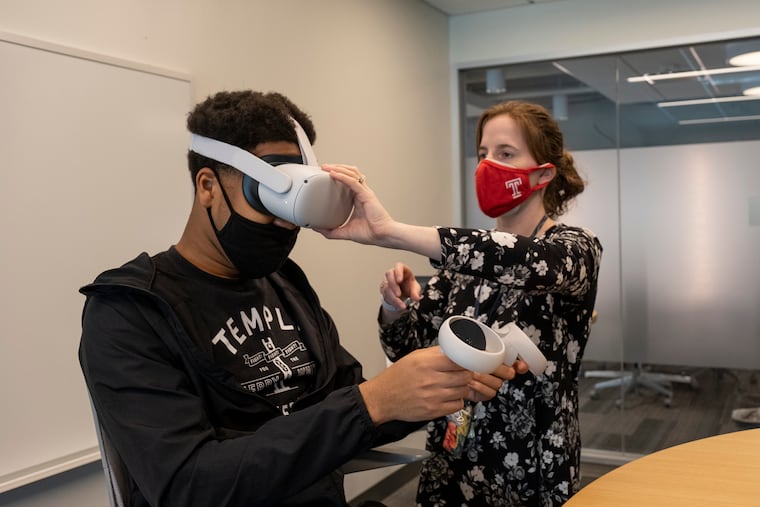Temple’s business school sees virtual reality as future of online learning
The Fox Business School is showcasing a virtual reality course that it hopes will be a model for future VR course in higher education.

Before the pandemic made online schooling a necessity, Bora Ozkan theorized that students learning remotely would be more engaged in virtual reality. Ozkan, a finance professor at Temple University and academic director of its online MBA, has tested that belief since March 2020, when he launched the class Fintech, Blockchain and Digital Disruption in a virtual reality, or VR, program.
It took 18 months to research the technology and build the course at a cost upward of $100,000. The finished product was completed with the help of Glimpse Group, a New York-based virtual reality and augmented reality company.
It’s an investment that Temple’s Fox Business School was excited to make because university officials hope it can become a model for higher education VR courses.
“When I teach classes on Zoom, there’s a disconnect,” Ozkan said. “When we asked students last year to compare their VR experience to Zoom, almost all of them said [VR] is better or much better. Which is why we decided to offer it again this year.”
VR allows for a digital environment where students are fully engrossed in their class, which he notes is a challenge even with in-person learning. When wearing the VR headset, students are not able to divert their attention to their cell phone or other distractions.
When the 18 students enrolled in the seven-week accelerated course this semester put on their VR headsets, they entered one of two lecture halls modeled after actual rooms on the Temple campus. Students customize their avatars before the semester. Though they appear in the room only as a floating head and pair of hands, students can engage by turning to speak with or listen to a classmate.
» READ MORE: Amazon now encircles the Philadelphia region with over 50 warehouses
When a student removes the VR headset, the avatar’s head droops, signaling that the person has left the discussion. In the future, the business school hopes to expand the technology’s capabilities so that it can allow students to visualize and interact with data sets.
Although students can participate in the course from anywhere — one enrollee is tuning in from Vietnam — VR has its limitations. The course is currently taught with Oculus Quest 2 headsets lent out by the university.
Fox School of Business dean Ron Anderson likens the state of VR to the rapid emergence of smartphone technology in the last decade. “Headsets today are what smartphones were six or seven years ago,” Anderson said. The technology is “changing rapidly, and eventually will start slowing down.” The VR headsets are cumbersome and eye fatigue sets in after about 45 minutes, keeping classes short.
Stephen Orbanek, a Fox Business School spokesman, said it plans to offer the VR course every spring semester, as long as there’s demand. The university is also looking into expanding its VR offerings, with an eye toward creating courses in its departments of Strategic Management, Human Resources Management, and Legal Studies.
Anderson said that a larger number of students enrolled for online schooling this fall than in prior semesters. He projects that about 20% of Fox School’s students will want to continue to attend school online after the pandemic.
He’s hopeful that VR technology will play a large role in online schooling in the future. “I would venture to guess in 20 to 25 years, this will become a primary form of education,” Anderson said. “It’s an incredible way to reduce costs and spread knowledge.”
» READ MORE: Pivot: How an EMT job can be a springboard for higher paying medical fields
Students now enrolled in the course said it is a welcome break from Zoom fatigue. “We’re all very busy. You don’t choose to do an online MBA program if you’re not otherwise busy,” said William Lavelle, an orthopedic surgeon in Syracuse, N.Y., who is enrolled in the VR course. “Always the temptation with Zoom, no matter how nice and honest we are, is to have something else going on. This encompasses your engagement.”
The course has logistical disadvantages. “I like the technology, I think it has a lot of potential, but you do start to get eye strain after about 30 minutes,” said Chris Thery, who is also enrolled in the course. Thery said the headset is uncomfortable and heavy, and it’s made more awkward by the glasses spacer he has to use.
But, he said, the technology also has perks. “It’s cool being in a classroom. You can just raise your hand like ‘hey, look at me!’ and not have to push the raise-hand button like on Zoom.”
The pandemic has necessitated innovation in remote learning. “There’s been a move to using high-quality interactive online learning environments,” said Ryan Baker, an associate professor at the University of Pennsylvania’s Graduate School of Education who studies how data can be used to improve online learning.
Baker points toward ALEKS, a platform that adapts to students’ knowledge base and creates a dynamic workload, as one environment that has seen a big user increase over the last year.
Baker predicted that although most schools will return to more traditional modes of teaching, the online platforms that gained a foothold during the pandemic will come to shape the future of homework by bringing it more online.
“These kinds of changes are always slow and partial and back and forth,” Baker said of the public’s growing acceptance of online schooling. “I would predict that, in five years, there will be more online learning than there was five years ago. And that increase is more than it would have been without the pandemic.”
The Future of Work is produced with support from the William Penn Foundation and the Lenfest Institute for Journalism. Editorial content is created independently of the project’s donors.